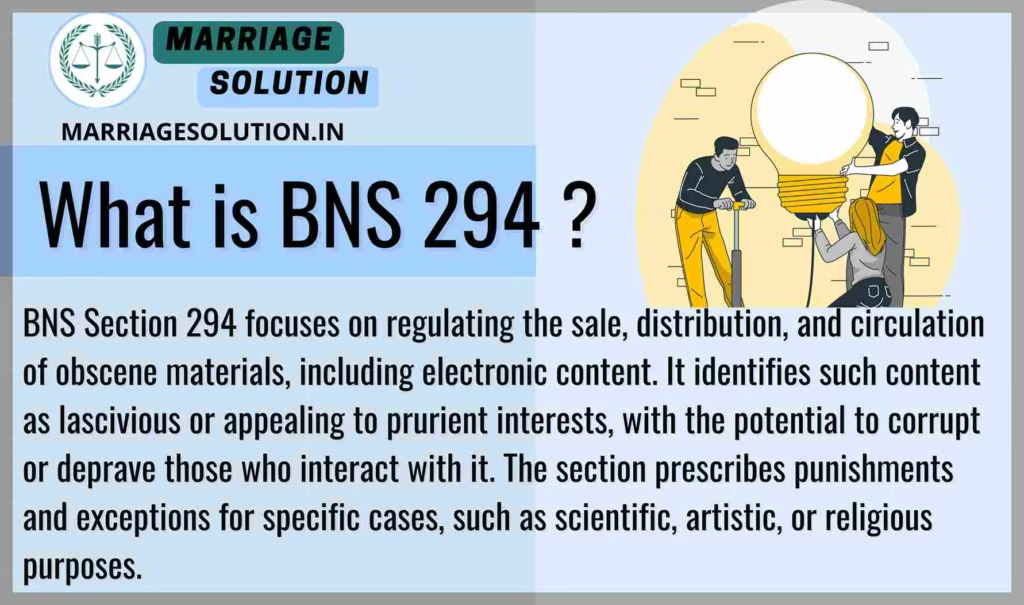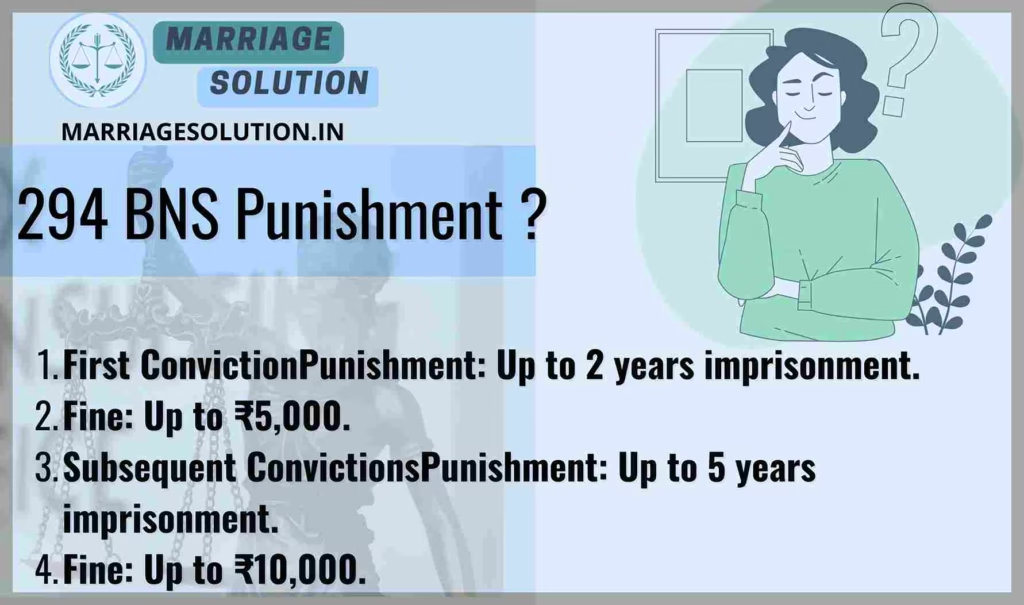Introduction of 294 BNS
294 BNS deals with the sale, distribution, and circulation of obscene materials. Such materials include books, drawings, writings, and even electronic content that can corrupt public morals or appeal to indecent interests. The section penalizes offenders while at the same time protecting works created for public good, such as those meant for art, literature, education, or religion. By clearly separating harmful content from legitimate expression, this law maintains public decency and also respects creative and cultural freedom.
The Bharatiya Nyaya Sanhita (BNS) Section 294 replaces the old Indian Penal Code (IPC) Section 292.
What is BNS Section 294 ?
BNS Section 294 focuses on regulating the sale, distribution, and circulation of obscene materials, including electronic content. It identifies such content as lascivious or appealing to prurient interests, with the potential to corrupt or deprave those who interact with it. The section prescribes punishments and exceptions for specific cases, such as scientific, artistic, or religious purposes.

Under Section 294 of the bns act 2023
“Whoever sells, lets to hire, distributes, publicly exhibits, or circulates, or makes, produces or has in his possession for that purpose any obscene book, pamphlet, paper, drawing, painting, representation or figure or any other obscene object whatsoever, shall be punished on first conviction with imprisonment for a term which may extend to two years and with fine which may extend to five thousand rupees, and, in the event of a second or subsequent conviction, with imprisonment for a term which may extend to five years and with fine which may extend to ten thousand rupees.”
1. Meaning of Section 294 – Sale of Obscene Materials
- This section punishes anyone dealing with obscene material — whether by selling, hiring, distributing, or exhibiting it.
- “Obscene” means content that is lascivious, appeals to indecent interests, or corrupts public morals.
- It applies to both physical objects (books, pamphlets, drawings, paintings) and digital content (videos, websites, e-books).
- The law balances public morality with freedom of art, literature, science, and religion by exempting works created for genuine public good.
2. Who is Covered?
This section applies to:
- Publishers or sellers of obscene books, magazines, or pamphlets.
- Digital content creators or website operators spreading obscene videos or images.
- Exhibitors who display obscene content in galleries, shops, or online platforms.
- Importers/exporters of obscene objects for commercial circulation.
- Anyone possessing obscene material with intent to circulate or profit from it.
3. Nature of the Offense
- Cognizable → Police can register and investigate without magistrate approval.
- Bailable → Accused can apply for bail as a matter of right.
- Non-Compoundable → Cannot be settled privately; must be dealt with in court.
- Triable by Any Magistrate → Local magistrates have jurisdiction to hear cases.
4. Examples of BNS Section 294
Example 1 – Selling Obscene Books
A shopkeeper sells obscene magazines containing indecent pictures. → Punishable under Section 294.
Example 2 – Online Distribution
A person uploads obscene videos to a paid website for profit. → Covered under this section.
Example 3 – Public Exhibition
An art gallery knowingly displays explicit, vulgar paintings only to attract customers. → Offense under Section 294.
Not Covered:
A medical textbook with graphic illustrations for scientific purposes, or temple sculptures (like Khajuraho), which fall under art/religious exceptions.
5. Punishment under BNS Section 294
- First Conviction → Imprisonment up to 2 years, or fine up to ₹5,000, or both.
- Subsequent Convictions → Imprisonment up to 5 years, or fine up to ₹10,000, or both.
6. Importance of BNS Section 294
- Protects public morality and decency from obscene content.
- Prevents the commercial exploitation of obscenity.
- Provides clearer modern wording compared to IPC Section 292, now covering digital/electronic content.
- Maintains a balance between restricting harmful obscenity and protecting legitimate freedom in art, science, education, and religion.
- Acts as a deterrent against repeat offenders by prescribing harsher penalties.
Section 294 BNS Overview
BNS Section 294 deals with the sale, distribution, or production of obscene materials, including books, drawings, or electronic content. It aims to prevent the circulation of items that are lascivious or harmful to public morality, while providing exceptions for works of public good or religious purposes.
10 Key Points with Detailed Explanations
1. Obscenity Defined
Obscenity includes books, drawings, electronic content, or other materials that are lascivious or intended to corrupt public morality. For example, a website hosting explicit content designed to exploit human emotions may fall under this category. The law targets materials with harmful effects on individuals’ thoughts or behavior. It ensures the protection of societal morals by discouraging such creations.
2. Actions Punishable Under the Law
This section punishes activities like selling, distributing, exhibiting, or producing obscene materials. For instance, a shopkeeper distributing pamphlets with explicit content for profit would face penalties. The provision emphasizes accountability for all who engage in creating or spreading obscenity, irrespective of intent or medium.
3. First Conviction Penalty
On a first conviction, offenders can face up to two years of imprisonment and a fine of ₹5,000. For instance, someone caught producing obscene images for a local market may receive this sentence. The relatively lighter punishment reflects an opportunity for offenders to reform before facing harsher penalties for repeated violations.
4. Repeated Offenses and Harsher Punishments
Subsequent convictions result in stricter penalties, including imprisonment of up to five years and a fine of ₹10,000. For example, a content creator repeatedly uploading explicit videos online despite warnings would face enhanced punishment. This acts as a deterrent to persistent violators and protects society.
5. Scope of Obscene Material
Obscene materials extend beyond physical items to include electronic forms like websites or digital documents. For example, hosting a blog promoting sexually explicit content falls under this category. The law ensures its relevance in the digital age by covering new mediums of distribution.
6. Exceptions for Public Good
Content related to science, literature, art, or public interest is exempt if proven beneficial. For instance, a medical textbook with graphic illustrations for educational purposes would not violate this section. This ensures the law doesn’t stifle academic and creative freedom while maintaining morality.
7. Religious and Cultural Exceptions
Religious representations, such as sculptures in temples or ancient artifacts, are excluded from the purview of this section. For example, erotic carvings on historic monuments like Khajuraho are protected as cultural heritage. This balance safeguards India’s rich historical and religious traditions.
8. Cognizable and Bailable Offense
The offense is classified as cognizable and bailable, meaning police can register and investigate cases without prior approval, but the accused can seek bail. This ensures prompt action while offering legal recourse to alleged offenders. For instance, a suspect in possession of obscene pamphlets can apply for bail post-arrest.
9. Commercial Exploitation
Individuals profiting from obscenity, such as owners of illegal adult websites, face severe scrutiny under this section. For instance, someone running a subscription-based website with obscene videos is liable for prosecution. This provision prevents economic gains from morally corrupt activities.
10. Safeguards Against Misuse
Clear definitions and exceptions prevent the misuse of this law. For example, artistic expressions in paintings or movies with significant societal messages are protected. These safeguards ensure enforcement targets genuine offenders without curbing legitimate freedoms of expression and art.
Examples for BNS Section 294
- Example 1:
A person publishes an e-book containing explicit, vulgar descriptions meant solely to excite inappropriate interests and sells it online. This act violates BNS Section 294 as it circulates obscene material harming public decency. - Example 2:
An art gallery owner imports obscene paintings to display for commercial purposes. Knowing the content is indecent, the owner can be prosecuted under BNS Section 294 for promoting obscenity through public exhibition.
BNS 294 Punishment
- First Conviction
- Punishment: Up to 2 years imprisonment.
- Fine: Up to ₹5,000.
- Subsequent Convictions
- Punishment: Up to 5 years imprisonment.
- Fine: Up to ₹10,000.

BNS 294 bailable or not ?
Yes, the offense under BNS Section 294 is bailable. This means the accused can seek bail after arrest and is not necessarily detained until trial. The provision ensures fair legal recourse while balancing enforcement of the law.
Comparison — BNS 294 vs IPC 292 (old)
| Section | What it Covers | Punishment / Fine | Exceptions | Bailable / Cognizable | Trial By |
|---|---|---|---|---|---|
| BNS Section 294 | Regulates sale, production, distribution, or exhibition of obscene materials, including digital or electronic content. Aims to protect public morality while respecting freedom of expression in art, literature, and religion. |
First conviction: Up to 2 years imprisonment or ₹5,000 fine. Repeat offence: Up to 5 years imprisonment or ₹10,000 fine. |
Exempts works of science, art, literature, or religion made for public good. Protects educational and cultural expressions. | Bailable & Cognizable | Any Magistrate |
| IPC Section 292 (Old) | Covered sale or distribution of obscene books, drawings, or objects. Focused mainly on printed or physical obscenity before the digital age. |
First conviction: Up to 2 years imprisonment or fine. Subsequent offence: Up to 5 years imprisonment or higher fine (not standardized). |
Similar exceptions for art, literature, and religion but lacked clear mention of digital or online media. | Bailable & Cognizable | Any Magistrate |
| Key Difference: BNS Section 294 modernizes IPC Section 292 by expanding scope to include digital and electronic media, fixing fine amounts, and providing explicit protection for artistic and educational works. It ensures public decency while adapting to the digital era. | |||||
BNS Section 294 FAQs
1. What is considered obscene under BNS Section 294?
Any material that is lascivious, appeals to prurient interests, or corrupts public morality is deemed obscene.
2. What are the penalties for violating BNS Section 294?
First-time offenders face up to 2 years in prison and ₹5,000 fine; repeat offenders face up to 5 years and ₹10,000 fine.
3. Are there any exceptions under this BNS Section 294?
Yes, materials serving the public good, educational, or religious purposes are exempt.
Conclusion
Section 294 of the Bharatiya Nyaya Sanhita ensures that harmful and obscene content does not circulate in society while making clear exceptions for genuine artistic, cultural, and educational works. The graded punishment system — lighter for first-time offenders and harsher for repeat violators — works as both a deterrent and a corrective measure. This section plays a vital role in protecting public morality, strengthening accountability, and safeguarding freedom of expression when used for public good.
Need Legal Support?
If you are dealing with court cases, marriage problems, or any other legal issue, our team at Marriage Solution – Lawyer Help is here for you. Simply fill out our quick online enquiry form, and we’ll connect you with the right legal expert to support your needs.
Finished with BNS 294 ? Continue exploring the next provisions of the Bharatiya Nyaya Sanhita (BNS), 2023. Each section includes explanations, examples, and plain-language breakdowns for easy understanding.
- 295 BNS : Sale, etc., of obscene objects to child.
- https://marriagesolution.in/bns_section/295-bns/
- 296 BNS : Obscene acts and songs.
- https://marriagesolution.in/bns_section/296-bns/
- 297 BNS : Keeping lottery office.
- https://marriagesolution.in/bns_section/297-bns/
CHAPTER XVI OF OFFENCES RELATING TO RELIGION
- BNS 298 : Injuring or defiling place of worship, with intent to insult the religion of any class.
- https://marriagesolution.in/bns_section/bns-298/
- 299 BNS : Deliberate and malicious acts, intended to outrage religious feelings of any class by insulting its religion or religious beliefs.
- https://marriagesolution.in/bns_section/299-bns/
Full IPC Section List: https://marriagesolution.in/ipc-section-list
All Indian Law & Blogs: https://marriagesolution.in/indian-law/
Full BNSS Section List: https://marriagesolution.in/bnss_section-list
